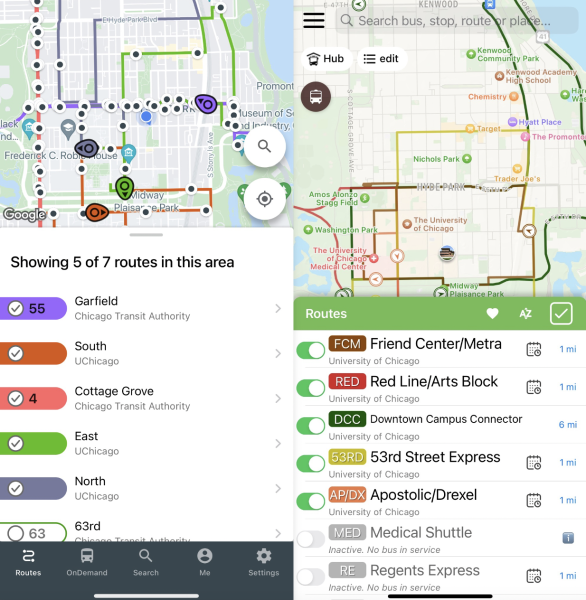At the beginning of spring quarter, the University announced that the current bus tracking app, TransLoc, was being replaced with a new GPS system, Passio GO!. TransLoc has been in use by the University since 2010 and will continue to be available until August 1, 2024, after which Passio GO! will be the only bus tracking system for UGo shuttles.
A University spokesperson responded to the Maroon’s request for comment with a written statement: “Under the new system, there is more direct connectivity between the Mobile Data Terminals on the shuttle and the application, so we expect accurate and reliable shuttle location information to show on the app. Secondly, our agreement with Passio GO! also allows us to make changes to the app if the functionality doesn’t meet our users’ needs.”
The University did not specify what changes had since been made to the app based on user feedback.
User reviews for Passio GO! are, however, fairly negative. As of May 1, 2024, the Passio GO! app had a 1.3/5 rating (with 484 reviews) on the Apple App Store and a 2.1/5 rating (with 543 reviews) on the Google Play store, while the TransLoc app had a 2.7/5 rating (with 1368 reviews) and a 2.9/5 rating (with 1515 reviews) on the two platforms respectively.
The Maroon spoke to Jack Zhang, a fourth-year in the College, about his experience with both apps. Zhang’s review of Passio GO! was mixed. “I live off-campus, and I need to take the 172 or 171 CTA bus to campus every day. I then take the East [UGo NightRide shuttle] back during the late evenings. Passio GO! doesn’t show the 171 and 172 CTA buses, which for me is a big problem,” he said. “I think Passio GO!’s success depends on if they can incorporate CTA bus tracking; that will make or break the app.” Zhang also stated that the Passio GO! interface felt “cluttered” and that it was difficult to identify incoming shuttles due to the small icon sizes.
Regarding TransLoc, Zhang said, “In general, it’s mostly reliable, but there are cases where the GPS tracking is not great. Usually, stations have an estimated time of arrival, but sometimes buses skip around.”

The Maroon also spoke with Dariel Cruz Rodriguez, president of the UChicago Transit Enthusiasts & Explorers and member of the Transportation Safety Student Advisory Board, about the change.
Rodriguez had a favorable opinion about Passio GO!. “We had several students on the Transportation Advisory Board test-run the app in the winter, including myself. Using Passio GO! has been generally a more positive experience than TransLoc due to the more frequent bus location updates.”
Rodriguez did suggest several improvements that could be made to the app: “Firstly, it would be useful to see how packed a certain shuttle is. This would be especially useful during peak times, such as later at night.” He also suggested that Passio GO! be more proactive with communicating which shuttles are inactive versus active. “Passio GO! should work to make inactive shuttle lines disappear off the map when those shuttles are not running.”
Moreover, Rodriguez has stated that the University is working with Passio GO! to integrate CTA and Metra routes into the app to give students more comprehensive information about different transportation options.
Finally, the Maroon spoke with Jefferson Lind, outgoing Undergraduate Student Government (USG) president, about the switch. When asked about his opinion on the switch from TransLoc to Passio GO!, he said, “USG as a whole is fairly skeptical of Passio GO!, but we get why they are doing it.”
“Passio GO! can accommodate more of the University’s options into one service. TransLoc is more limited to the bus system. However, in trying to understand the experience of other universities with Passion GO!, the app appears to be quite buggy.” Lind stated that University administration made USG aware of this transition from TransLoc to Passio GO!, but USG did not play a role in the decision-making process.
Lind suggested several major improvements related to the University’s new proposed ride share service, Via: “It would be super useful to see not only proximity to the nearest shuttle, but also proximity to the nearest Via ride.” Lind hopes that the integration between ride-sharing services and shuttle routes will make it easier for students to get around.
“I would encourage the student community and the future student government to hold the school accountable if the program is not meeting student standards,” Lind said.








